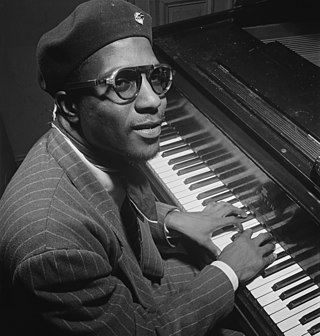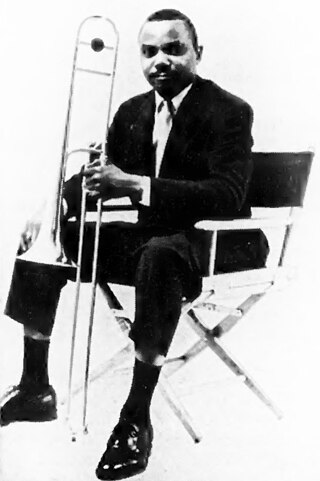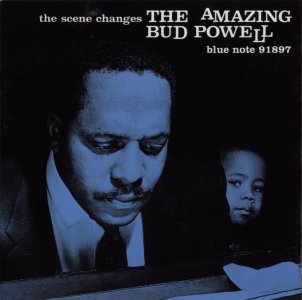Related Research Articles

Thelonious Sphere Monk was an American jazz pianist and composer. He had a unique improvisational style and made numerous contributions to the standard jazz repertoire, including "'Round Midnight", "Blue Monk", "Straight, No Chaser", "Ruby, My Dear", "In Walked Bud", and "Well, You Needn't". Monk is the second-most-recorded jazz composer after Duke Ellington.

J. J. Johnson, born James Louis Johnson and also known as Jay Jay Johnson, was an American jazz trombonist, composer and arranger.

Earl Rudolph "Bud" Powell was an American jazz pianist and composer. A pioneer in the development of bebop and its associated contributions to jazz theory, Powell's application of complex phrasing to the piano influenced both his contemporaries and later pianists including Walter Davis, Jr., Toshiko Akiyoshi, and Barry Harris.

Horace Ward Martin Tavares Silver was an American jazz pianist, composer, and arranger, particularly in the hard bop style that he helped pioneer in the 1950s.

John Aaron Lewis was an American jazz pianist, composer and arranger, best known as the founder and musical director of the Modern Jazz Quartet.

Theodore "Fats" Navarro was an American jazz trumpet player and a pioneer of the bebop style of jazz improvisation in the 1940s. A native of Key West, Florida, he toured with big bands before achieving fame as a bebop trumpeter in New York. Following a series of studio sessions with leading bebop figures including Tadd Dameron, Bud Powell, and Kenny Clarke, he became ill with tuberculosis and died at the age of 26. Despite the short duration of his career, he had a strong stylistic influence on trumpet players who rose to fame in later decades, including Clifford Brown and Lee Morgan.

St. Elmo Sylvester Hope was an American jazz pianist, composer, and arranger, chiefly in the bebop and hard bop genres. He grew up playing and listening to jazz and classical music with Bud Powell, and both were close friends of another influential pianist, Thelonious Monk.

George Wallington was an American jazz pianist and composer. Born in Sicily, his career as a pianist began in the early 1940s, when he played with Dizzy Gillespie and Charlie Parker and contributed to the development of bebop. Following several years as a sideman during the late 1940s, he formed his own group, experimenting with trios and a string ensemble before settling upon a permanent quintet.

Richard Powell was an American jazz pianist, composer, and arranger. He was not assisted in his musical development by Bud, his older and better known brother, but both played predominantly in the bebop style.
Solfeggietto is a short solo keyboard piece in C minor composed in 1766 by Carl Philipp Emanuel Bach. Although the Solfeggietto title is widely used today, according to Powers 2002, p. 232, the work is correctly called Solfeggio, but the author provides no evidence for this. Owens refers to the work as a toccata.

The Amazing Bud Powell is a ten-inch LP by American jazz pianist Bud Powell, recorded on August 8, 1949 and May 1, 1951 and released on Blue Note in April 1952. In the first session, Powell performed in quintet with Fats Navarro, Sonny Rollins, Tommy Potter and Roy Haynes, and in trio with Potter and Haynes. In the second, Powell performed in trio with Curley Russell and Max Roach, and solo.

The Amazing Bud Powell, Vol. 2 is a ten-inch LP by American jazz pianist Bud Powell recorded at WOR Studios in New York on August 14, 1953 and released on Blue Note the following year. Powell is backed by rhythm section George Duvivier and Art Taylor.

Bud!, also known as The Amazing Bud Powell, Vol. 3, is a studio album by American jazz pianist Bud Powell recorded at the Rudy Van Gelder Studio in Hackensack, New Jersey on August 3, 1957 and released on Blue Note later that year. Powell is backed by rhythm section Paul Chambers and Art Taylor, with guest appearances from trombonist Curtis Fuller on three tracks.

The Scene Changes, also known as The Amazing Bud Powell, Vol. 5, is a studio album by American jazz pianist Bud Powell recorded at the Van Gelder Studio in Hackensack, New Jersey on December 29, 1958 and released on Blue Note the following year. Powell is backed by rhythm section Paul Chambers and Art Taylor.
Bouncing with Bud is a 1946 jazz standard by American pianist Bud Powell and Gil Fuller, which features the saxophone of Sonny Stitt and the trumpet of Kenny Dorham. It was originally recorded on 23 August 1946 as "Bebop in Pastel". In the key of B-flat major, the tune is a "nonblues theme whose form is A-A'-B-A' with an eight-bar interlude that is not played during the solos."
"Glass Enclosure" is a composition by jazz pianist Bud Powell. The first recording was Powell's version for Blue Note Records in 1953, which was released as part of the album The Amazing Bud Powell, Vol. 2 the following year. It was also released as one side of a single, with "I Want to Be Happy".

Francis Paudras was a French musician and author best known for La Danse des Infidels, his memoir of jazz pianist Bud Powell.
Mythic Sound is an American record label that released a series of recordings of Bud Powell titled Earl Bud Powell, grouped in eleven albums. The albums were released in 1989.

The Amazing Bud Powell, Vols. 1 & 2 are a pair of separate but related albums by American jazz pianist Bud Powell, recorded on August 8, 1949, May 1, 1951, and August 14, 1953, and released on Blue Note in 1956, compiling Powell's first three session for the label, originally released on ten-inch LPs as The Amazing Bud Powell (1952) and The Amazing Bud Powell, Vol. 2 (1954).
References
- 1 2 Ramsey, Guthrie P. (2013). The Amazing Bud Powell: Black Genius, Jazz History, and the Challenge of Bebop (1 ed.). University of California Press. ISBN 978-0-520-24391-0. JSTOR 10.1525/j.ctt2jcc05.
- 1 2 "The Party Trick | Hear Me Out". WQXR. 2020-09-04. Retrieved 2024-03-14.
- ↑ Cerulli, Dom (February 20, 1958). "Bud Powell: Bud! The Amazing Bud Powell". DownBeat . pp. 26–27.